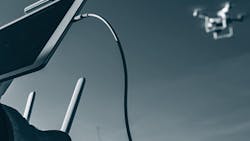FAA orders use of Remote Identification for drones
In this week’s roundup from the Association for Unmanned Vehicle Systems International, which highlights some of the latest news and headlines in unmanned vehicles and robotics, the FAA announces new rule for night flights and UAS operations over people, and police officers in Port St. Lucie, Florida use drones to locate two missing children.
FAA announces Remote ID and operations over people final rules for UAS
On Monday, December 28, 2020, the FAA announced two final rules for UAS. The new rules will require Remote Identification (Remote ID) of drones and allow small UAS operators to fly over people and at night under certain conditions.
According to the FAA, Remote ID will help mitigate risks associated with expanded drone operations, such as flights over people and at night. Both rules also support technological and operational innovation and advancements.
“These final rules carefully address safety, security and privacy concerns while advancing opportunities for innovation and utilization of drone technology,” U.S. Secretary of Transportation Elaine L. Chao said at the time of the announcement.
Considered a major step toward the full integration of drones into the national airspace system, Remote ID provides crucial information such as the identification of drones in flight, as well as the location of their control stations, to national security agencies and law enforcement partners in the U.S., and other officials charged with ensuring public safety. The FAA notes that airspace awareness reduces the risk of drone interference with other aircraft and people and property on the ground.
Equipping drones with Remote ID technology builds on previous steps taken by the FAA and the drone industry to integrate operations safely into the national airspace system. While Part 107 of the federal aviation regulations currently prohibits covered drone operations over people and at night unless the operator obtains a waiver from the FAA, the new FAA regulations jointly provide increased flexibility to conduct certain small UAS without obtaining waiver.
“The new rules make way for the further integration of drones into our airspace by addressing safety and security concerns,” FAA Administrator Steve Dickson says. “They get us closer to the day when we will more routinely see drone operations such as the delivery of packages.”
The Remote ID rule applies to all operators of drones that require FAA registration. There are three ways to comply with the operational requirements:
1. Operate a standard Remote ID drone that broadcasts identification and location information of the drone and control station;
2. Operate a drone with a Remote ID broadcast module (may be a separate device attached to the drone), which broadcasts identification, location, and take-off information; or
3. Operate a drone without Remote ID but at specific FAA-recognized identification areas.
The Operations Over People and at Night rule applies to Part 107 operators. The ability to fly over people and moving vehicles varies depending on the level of risk a small drone operation presents to people on the ground. Operations are permitted based on four categories, which can be found in the executive summary accompanying the rule. Additionally, this rule allows for operations at night under certain conditions.
The final rule requires that small drone operators have their remote pilot certificate and identification in their physical possession when operating, ready to present to authorities if needed. This rule also expands the class of authorities who may request these forms from a remote pilot. The final rule replaces the requirement to complete a recurrent test every 24 calendar months with the requirement to complete updated recurrent training that includes operating at night in identified subject areas.
Both rules will become effective 60 days after publication in the Federal Register. The Remote ID rule includes two compliance dates. Drone manufacturers will have 18 months to begin producing drones with Remote ID, with operators having an additional year to start using drones with Remote ID.
“AUVSI welcomes the progress made with the delivery of these final rules,” AUVSI President and CEO Brian Wynne said after the rules were announced. “Remote ID will enable more complex UAS operations, which will have additional untold benefits for American society. Operations over people, and at night, are important steps towards enabling integration of drones into our national airspace. We look forward to reviewing these rules and working with the FAA on implementation.”
Drone helps locate missing children in Florida
A drone helped police officers in Port St. Lucie, Florida, locate two missing children on Sunday, Jan. 3.
Two families were having a playdate when two children slipped out the front door of a home. Police were called and conducted a quick search of the immediate area, but there was no sign of the children.
Two officers—one serving as the drone pilot and another serving as the visual observer—were called into action and found the children walking along a lake near the home. The officer serving as the drone pilot for the mission hovered the drone over the children until the family picked them up.
"Needless to say, both worried families, were appreciative of the efforts of PSLPD," the police department posted on its Facebook page.
Compiled by Brian Sprowl, Associate Editor, AUVSI
Share your vision-related news by contacting Dennis Scimeca, Associate Editor, Vision Systems Design
SUBSCRIBE TO OUR NEWSLETTERS
